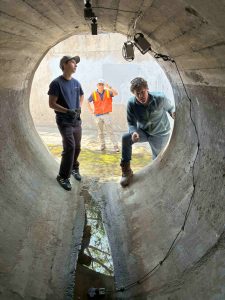Study investigates using low-cost sensors to automate detection of illicit discharges

staff inspect low-cost field sensors installed at the end of a storm drain in Tustin. SCCWRP and its
partners are investigating the feasibility and logistics of using these sensors to automate detection
of illicit pollutant discharges that can pass rapidly through storm drain systems.
SCCWRP and Orange County Public Works have launched a two-year study investigating the feasibility and logistics of using low-cost field sensors to automate detection of illicit pollutant discharges that can pass rapidly through storm drain systems – a real-time monitoring approach that has the potential to improve managers’ ability to detect illegal dumping activities.
The project, which began in May by deploying prototype sensors at eight sites across Orange County, will generate a continuous stream of real-time flow and water-quality data as dry-weather runoff moves through storm drains, enabling managers to look for fluctuations in the monitoring data that could be indicative of transitory discharges, such as oil, sewage and other pollutants being dumped into storm drains.
Researchers’ goal is to determine whether the prototype sensors – which incorporate 3-D printed parts and commercially available electronic components that run on open-source code – could replace traditional sampling designs, which consist of periodic, in-person field sampling during dry weather. This traditional monitoring approach can limit managers’ chances of detecting transitory pollutant discharges. Additionally, processing field samples can take weeks to generate results, further hampering managers’ chances of detecting an illicit discharge and then being able to track it back to an upstream source.
By contrast, automated monitoring produces a continuous stream of real-time data, so managers can look for spikes and other sudden changes in water quality and flow that become the basis for focused source-tracking follow-up work.
The study follows the successful completion of a small-scale pilot study in Orange County storm drains last year.
Among the issues the study is evaluating are the logistical challenges associated with implementing and operating a network of field sensors, including maintaining an internet connection for every sensor, storing and analyzing sensor data, and deterring potential vandalism and theft of the sensors. Researchers are evaluating how to mitigate these challenges, as well as whether the benefits of such a sensor network will outweigh potentially unavoidable disadvantages.
The sensors were developed by the BoSL Water Monitoring and Control Research Team, an Australian research team based at Monash University and Queensland University of Technology in Australia. The technology also is being pilot-tested in Australia.
BosL’s sensors cost just a few hundred dollars each – about 98% less than comparable sensors that are commercially available – and use components that are commercially available or can be made with a 3-D printer.
The sensors operate as the “internet of things” (IoT) – a network of devices and technology – that store and automatically upload collected data to an online database that can be accessed remotely. Researchers are using the sensors to track five monitoring parameters: water depth, velocity, temperature, conductivity, and turbidity. They will evaluate if one or a combination of these parameters can effectively indicate to managers evidence of a potential illicit discharge.
Stormwater agencies are required under their National Pollutant Discharge Elimination System (NPDES) discharge permits to actively monitor storm sewer systems to detect and eliminate illicit discharges.
In advance of a second round of dry-weather sampling next year, SCCWRP will train Orange County Public Works staff on field deployment, sensor maintenance, and data analysis.
For more information, contact Dr. Elizabeth Fassman-Beck.
More news related to: Stormwater BMPs, Top News